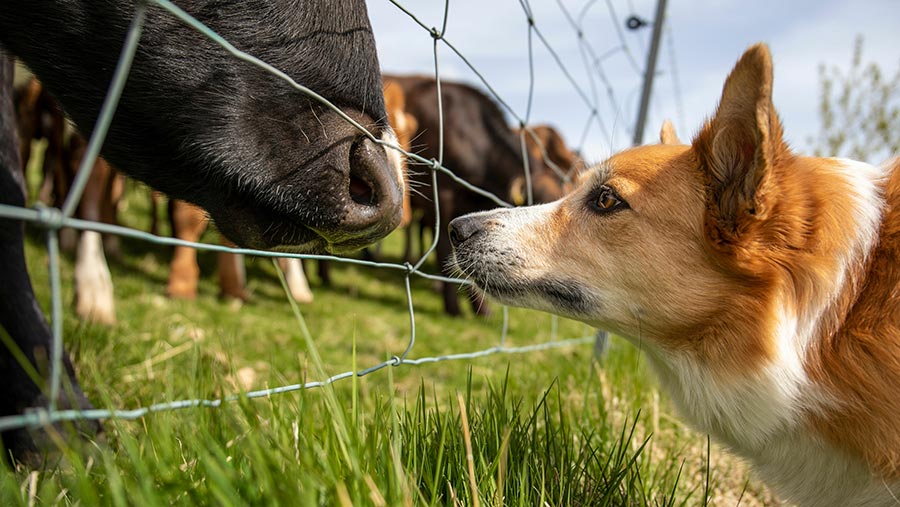The risks of dog faeces to livestock and how to prevent them
 © Elin5/Wirestock Creators
© Elin5/Wirestock Creators Having five carcasses condemned for discolouration caused by cysts has cost a farm dearly and highlighted the issue of the dangers of dog muck.
The costly case happened in 2021 and was written up by colleagues in the Journal of Veterinary Parasitology in 2022 (see “Farm hit with cyst condemnations”).
See also: Guide to understanding a beef killing-out sheet
This is not a fallen stock story, but the result is the same – the affected cattle did not enter the food chain and all the cost and time of feeding and management was for nothing.
This makes the issue of dogs on farmland a perennial problem (see “What are the three key health challenges of dog muck?”) and worth discussion.
The offending parasite was a sarcocyst. These are found globally in all kinds of animals, from tree shrews to elephant seals. They can be both disease-causing and harmless.
The term eosinophilic myositis is given to muscle tissue when it is discoloured by the degradation of a sarcocyst. This is caused by a hypersensitivity reaction and can result in a green or yellow mottling in meat.
Benign sarcocysts are commonly found in all tissues in sheep and cattle. What triggers the sensitivity reaction is unknown.
Farm hit with cyst condemnations
- Farm 250 native-cross suckler cows grazing on home pasture
- Affected stock 22 home-bred steers and heifers were slaughtered at 20-24 months, of which five were affected with cysts
- Context Cattle had grazed at home. Some public footpaths went through the farm, the farm had dogs and the local fox hunt had passed through with the hounds. There were no campsites nearby
- Cost In today’s money, five 350kg carcasses at £5/kg are worth £8,750, which, divided by 250 cows, equals £35 a cow
Dogs on the rise
According to a 2023 survey by statistics database Statista, 31% of UK households reported dog ownership, compared with 22% in 2011.
Furthermore, a Vetoquinol survey of 2,000 UK dog owners in July this year found that 33% walked dogs near livestock, and 36% said they would be more likely to leave dog poo behind if it was in a rural field.
(Vetoquinol makes Droncit, a tapeworm tablet containing praziquantel, which effectively kills tapeworms, but not neospora or sarcocysts.)
This suggests that graziers are best reminded of the dangers of dog faeces and offered some ideas as to how to limit the issue when the public have access to land.
Prevention
With no treatment available for issues such as neosporosis and sarcocystosis, prevention is the only way:
- Concentrate on fields with rights of way through them and encourage dog walkers to remove dog faeces
- Supplying a poo bag dispenser and a bin is a minimal cost and may save you losses, but may also become depended on by walkers
- Make efforts to get to know regular dog walkers, as they can educate others
- Ensure farm dogs are trained to a latrine or kennel area and have no need to defecate on grazing land
- Do not let dogs eat carcasses, placentas or foetuses
- Consider signage encouraging dog walkers to worm dogs with praziquantel
- Improvements might also reduce the chances of sheep worrying, which can also result in losses, abortions and graphic injury
The three key health challenges of dog muck
Sarcocystosis (eosinophilic myositis)
What is it?
- A protozoan intracellular infection often associated with producing muscle cysts (sarcocysts)
- Different species-specific predator-prey lifecycles have been identified for different species, namely cattle-to-dog transmission (S cruzi) and sheep-to-dog transmission (S capracanis, S hircicanis)
- Has a two-host cycle, reproducing asexually in the intermediate host
- Sheep and cattle can graze or eat feeds contaminated with faeces containing infective sporocysts (passed by dogs or foxes). These penetrate the intestinal wall and multiply in blood, heart, skeletal muscles and even nerve cells. They take about three months to mature
- The cysts are often microscopic and embedded in cattle muscle
Its impact
- Cattle with S cruzi can suffer fever, anorexia, lower milk production, loose dung, loss of tail hair, weakness and even death. It can cause similar effects in sheep, along with abortion
- The condition offers no threat to human health but is covered under the Fresh Meat (Hygiene and Inspection) Regulations 1995 of the UK as being unfit for human consumption
How to manage it
- Prevent ingestion of prey carcasses or raw tissues by dogs and foxes and reduce grass and water contamination with their faeces
Neospora
What is it?
- A cyst-causing protozoan parasite that is sexually mature and reproduces in dogs and other canids (foxes)
- It starts life as a tissue cyst in an intermediate host (typically cow, deer or dog), where it reproduces asexually
- Cattle can become infected at pasture and then infect gestating calves as foetuses. It is estimated that about 90% of neospora cases in calves are congenital infections, according to the National Animal Disease Information Service
- Parasites can be maintained and propagated between the definitive and intermediate hosts for many years within the same herd
Its impact
- The Animal and Plant Health Agency reports Neospora caninum as the most commonly diagnosed cause of abortion in dairy cattle
- High rates of abortions, and calves born with the disease are often weak, underweight and have neurological symptoms such as inco-ordination and eye protrusions
How to manage it
- A vaccine did exist but was withdrawn due to questionable efficacy
- Farmers are recommended to not retain replacements from infected (seropositive) cows, as they can pass the disease to their calves during gestation (infection is not cow-to-cow)
- Blood testing can identify positive animals, which can be culled or bred to beef. Ensure only negative females are bred from
- Maintain high hygiene standards at calving so placental membranes and aborted calves cannot be eaten by dogs or foxes
- Minimising dog faeces on pasture can avoid transmission between cattle and dogs
- Stop dogs accessing feed storage areas, feeding areas or calving pens
Tapeworms
What is it?
- A flat, segmented worm, often white in appearance. Its head has hooks that attach to the gut wall of sheep and cattle
- Moniezia expansa is the most common species in the UK, often seen being passed by sheep. This is not spread by dogs, but by a mite, and is considered harmless to sheep
- Some other tapeworm species (for example, Echinococcus granulosa, the cause of hydatid disease) reproduce in other species (usually dogs or foxes) as intermediate hosts
- Taenia multiceps can lead to large cysts forming in the brain causing coenurosis (known as “sturdy” or “gid”)
Its impact
- Moniezia expansa has very little impact
- Hydatid cysts in carcasses can lead to condemnation
- Occasionally, numbers of Moniezia expansa worms can be great enough to cause loss of condition, diarrhoea and even intestinal obstruction
How to manage it
- Not all wormers treat tapeworm, but albendazole, oxfendazole, fenbendazole and ricobendazole are often effective
- Check whether the farm dogs need worming (with praziquantel)

